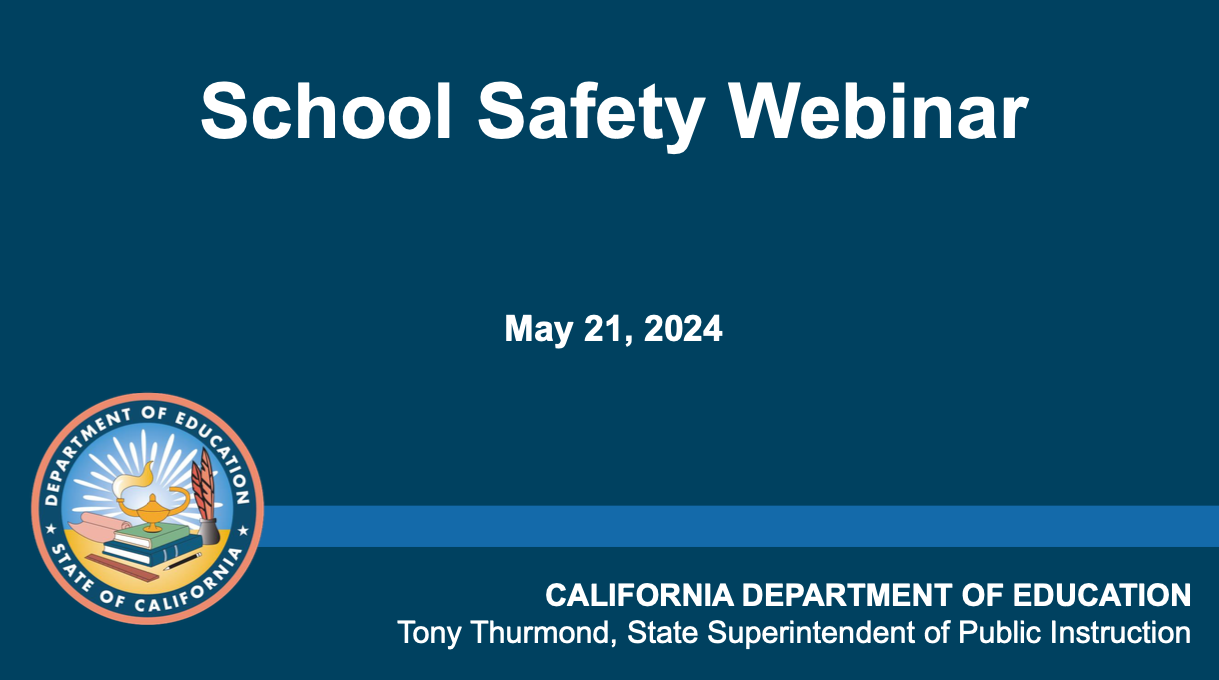Last updated 9/5/24
1. Continue crisis communications with all stakeholders
In the aftermath of an incident, communication is critically important. Many checklists and toolkits are available to assist staff with “ready made” templates to help focus the information. If your district does not have a communication person, contact your county office of education for available support.
Tips:
- Identify key contact people for each constituent group, including families, media, and law enforcement.
- Assure the safety of staff and students.
- Have a school/district spokesperson available and informed.
- Furnish accurate information on the crisis or emergency.
- Maintain confidentiality of student and employee information, as required by law.
- Cooperate and coordinate with law enforcement personnel.
Resources:
CSBA Media Relations During a Crisis – The California School Board Association created this simple manual for schools to use with the media during a crisis and afterward.
2. Conduct meeting as promptly as possible with all staff
Staff must be informed of key information in a confidential staff meeting. Consider a safe place if you cannot return to the school site, such as a community room in a local business or another school site. The following should be considered when planning the staff meeting:
- Provide any facts that can be shared.
- The role of the district in supporting and protecting employees, and how they can protect themselves.
- The method and timing of ongoing communication.
- Don’t answer questions that you do not have the answers to or that you are unsure of.
- Where they can go for additional help.
- Identify the district spokesperson who will be the point person for media and other communication, realizing that staff members do have a First Amendment right of free speech. Remind them that anything they say can be used in the future in legal proceedings.
3. Deploy mental health and bereavement professionals, and social workers
It is important to deploy mental health and bereavement professionals, and social workers to provide short and long-term support to students, staff, and the broader school community. While it is important these professionals provide supports at the location of the incident, it should be recognized that students and staff at neighboring schools may need professional support as well. Students and staff at other local schools may have family members or other loved ones who were injured or killed during the incident. In addition to mental health and bereavement professionals, consider bringing in therapy dogs.
National Center for School Crisis and Bereavement (NCSCB) – For free, immediate technical assistance and training focused on short and long-term recovery, contact the National Center for School Crisis and Bereavement (NCSCB) at or 877-53-NCSCB (877-536-2722). They have provided countless school districts in California (and beyond) immediate free support. This should be one of the first calls your district makes after an emergency.
Resources:
The National Center for School Crisis and Bereavement, and the National Association of School Psychologists offer additional resources for addressing the mental health needs that arise after a crisis:
- NASP Addressing Grief Resources – The National Association of School Psychologists provides resources to help with addressing grief and crisis for staff and students.
- American Psychological Association – This link has information regarding “What are common reaction and response to a disaster?”, “How do I cope?”. There are also links to featured topics for further research.
- Trauma Informed California – This website provides many resources for responsiveness to different types of trauma, including violence, disasters, death, etc. This is a great one to share with your school psychologists, counselors, and other support personnel.
4. Provide Human Resources support
Staff will require ongoing long and short term support after a major incident. Your Human Resources Department will play a critical role in communicating the availability of support services to staff.
Tips:
- Employee Assistance Programs – Many districts have EAPs in place that provide counseling and support services to staff. Informing staff of the services available is a good first start after an emergency.
- County victim witness program. This program provides funding for anyone who is victim of a crime to for counseling services.
- Workers compensation services.
- Consider that staff may require short and long term relief. Think through how to provide large numbers of substitutes, including classified, certificated, and management. Substitute should be ready to plug in when needed.
- Reassignment of staff may be a consideration, for staff and teachers who need to change sites due to mental health reasons. Sometimes returning to a place of trauma may be too much for some staff members.
- Flexible scheduling for staff may be a consideration. Be flexible with staff and teachers who are unable to work for an entire school day due to mental health-related reasons.
- Benefits for survivors and/or family of the deceased will need to be considered in the immediate aftermath of a tragedy. Work with your insurance company as quickly as possible.
5. Immediately after the incident, consider whether to repair, relocate or rebuild the facility
Deciding to repair, relocate or rebuild a facility can be very difficult ones for school leaders, but time is of the essence. If the site will be closed down for any ongoing investigation, consider relocating the students as soon as possible to other schools or locations.
The longer a school goes without being repaired, the longer students, families and staff will be impacted. If the decision is made to restore and return students as quickly as possible, it needs to be returned to how it looked prior to the incident.
Here are other facility considerations:
- When the ”crime scene” has been cleared to the district, immediately put up yellow-tape to close down certain areas. This will keep unwanted people from accessing sensitive areas until you deem them clear for public access. This includes the media and “looky-loos” that will inevitably enter any area that you have not marked or blocked off.
- Hire emergency clean-up services after law enforcement has completed its work.
- Hire security to continue to secure site and keep people away from sensitive areas.
6. Engage counsel to prepare for legal issues that may arise
Before beginning any press conferences, bring in your district counsel. They can assist with the information that can be shared and timelines for that information.
In the aftermath of a tragedy, anything said by the district and staff can and will be used in legal proceedings, so it is imperative that legal guidance be effectively and immediately engaged.
7. Debrief the event with key decision-makers on lessons learned, utilizing an after action report
An after action report is a structured review and debrief process for analyzing what happened, why it happened, and how it can be done better by the participants and those responsible for the project or event response.
Sample after action review meeting agenda:
- Welcome, introduction, and context for this review
- Ground rules and role of facilitator
- What was intended?
- What actually happened?
- What went well, and why?
- What can be improved, and how?
- The way ahead: Closing comments and preparation for the report
Resources:
After Action Video – The San Bernardino City Unified School District created this video to help school districts review the incident and response actions after an emergency. It is recommended that the first review take place the day of the event and then additional follow-up after that time.
After Action Report – A fillable report template for use after an incident.
8. Identify relief resources
Reach out to your insurance company as quickly as possible. It would be beneficial to designate one person to address immediate issues related to accessing key resources available from your district insurance company.
Tips:
- Check with your county office of education for support and resources
- Check for state and federal grant relief sources, including those listed below.
Resources:
- Butte County Crisis Response Kit – This padlet contains resources compiled by the Butte County Office of Education in response to fires in their area. However, the trauma response resources here can be used for any type of crises that exceed a school/district’s capacity to respond, from man made to natural disasters.
- California Victim Compensation Board – The board has resources that can help pay bills and expenses that result from violent crime. Victims of crime who have been injured or have been threatened with injury may be eligible for help.
- California Department of Education ADA Recovery – This is the direct link to obtain attendance and instructional time credit for days missed due to school closure.
- U.S. Department of Education Emergency Response to Violence Grant – The U.S. Department of Education offers the School Emergency Response to Violence Grant (Project SERV) to provide education related services to districts where learning environments were disrupted, due to a traumatic crisis.
9. Conduct school community follow-up meetings
Develop a plan to share information with families and community members. Ask for input to improve response and follow up.
Tips:
- Consider location(s) to best meet community needs and involve the entire community impacted.
- Get assistance from professional on agenda and format.
- Use the most skilled facilitator you have in your district to host the discussion and subsequent conversations.
- Consider hosting more than one community follow-up meeting to accommodate families with differing schedules. This will also help to diffuse the crowds, and the context of the first meeting can be used to help improve subsequent meetings.
- Consider the following as an outline for a community meeting:
- Welcome, introduction, and context for the meeting
- Ground rules and role of facilitator
- What was intended?
- What actually happened?
- What went well, and why?
- What can be improved, and how?
- Next steps, moving forward
10. Schedule events to honor tragedies and those who passed
In the event that you have lost students, staff, and/or members of the school community, it is important to honor the grieving process in the aftermath of a tragedy. The following are tips that will help your team think through ways to honor events and individuals.
Tips:
- Facilitate grieving in a healthy manner.
- Donations will flow into the school, so identify a staff person who can assist with gathering and aggregating the donations.
- Set up a fund for those who want to donate to families who have experienced losses, as this information will be requested by others.
- As the anniversary of a tragedy approaches, consider what would be helpful to honor those affected by the event.
- Be cautious of the placement of any permanent memorials, as those can be triggering for staff and students who experienced the tragedy.
11. Scrutinize vendors offering free services
After an incident, a wide array of vendors will offer services that sound attractive, including public relations, facility, and counseling services.
Be sure to vet providers with ACSA or other trusted partners. (Learn more about ACSA’s vetted partners.)
Read More:


































